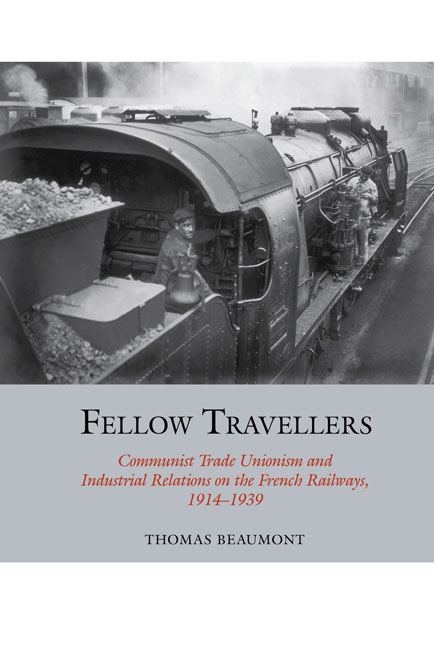 Fellow Travellers
Fellow Travellers Book contents
- Frontmatter
- Contents
- Acknowledgements
- Introduction
- 1 Railway Workers at War
- 2 Railway Workers and the ‘Après Guerre’
- 3 Railway Workers and the Communist Choice
- 4 Stabilisation
- 5 International Connections
- 6 ‘Hostile Participants’: Communists and Railway Industrial
- 7 Railway Workers and the Popular Front: From Victory to Defeat, 1934–1939
- Conclusion
- Bibliography
- Index
7 - Railway Workers and the Popular Front: From Victory to Defeat, 1934–1939
- Frontmatter
- Contents
- Acknowledgements
- Introduction
- 1 Railway Workers at War
- 2 Railway Workers and the ‘Après Guerre’
- 3 Railway Workers and the Communist Choice
- 4 Stabilisation
- 5 International Connections
- 6 ‘Hostile Participants’: Communists and Railway Industrial
- 7 Railway Workers and the Popular Front: From Victory to Defeat, 1934–1939
- Conclusion
- Bibliography
- Index
Summary
For a brief period, the events of May–June 1936 transformed the social and political landscape in France. Following almost two decades of employer ascendancy and the relative impotence of the labour movement in France, divided as it was into often warring communist and non-communist factions, a re-united and supremely confident CGT seized back the initiative. A massive surge in rank and file militancy following the election of the first Socialist prime minister in the nation's history led to widespread strikes across French industry and commerce beginning in May 1936 and carrying on through the following months. Alongside the strikes French workers adopted the relatively novel tactic of occupying their workplaces, raising among some the hopes, and fears, of an impending revolution. Beginning among aircraft workers in Le Havre and Toulouse on 11 May the strike wave quickly spread, first through other aircraft factories before broadening out through other industrial sectors. By the end of the month the strikes had reached the Parisian banlieues and had increased dramatically in scale. On 1 June there were ten occupied workplaces in the Paris region. By midday on 2 June this had reached 66, and by that evening 150 workplaces had been occupied. As economic activity began to grind to a halt, the newly elected Popular Front government responded. On 6 June the newly elected Prime Minister Léon Blum announced in parliament that the government would be immediately implementing a programme of social legislation. Employers were thrust onto the back foot. In secret talks the following day with representatives of major industrialists at the prime minister's official residence, the Hôtel Matignon, the Popular Front government exacted significant concessions which fundamentally recast social relations in the workplace. As a result of these concessions, French workers now had the right to join unions, elect shop stewards to represent them in negotiations with management and gained pay increases across the board. This sudden, unsolicited extension of trade union power within the workplace was one of the major achievements of the Popular Front government. It was as, Herrick Chapman notes, a ‘stunning breakthrough for the CGT’. The Matignon Accords were announced on Monday 8 June, yet they failed initially to curtail the strikes. Occupations persisted through June, finally petering out in early July, at which point 12,000 workplaces had been affected by the strikes, with 9,000 occupied.
- Type
- Chapter
- Information
- Fellow TravellersCommunist Trade Unionism and Industrial Relations on the French Railways, 1914–1939, pp. 203 - 238Publisher: Liverpool University PressPrint publication year: 2019
